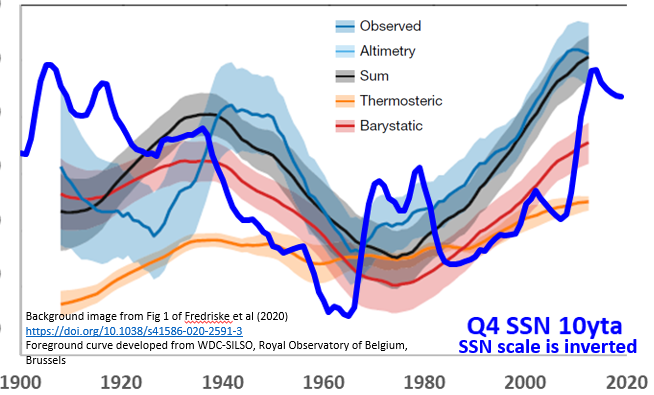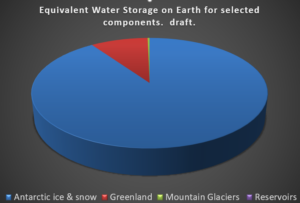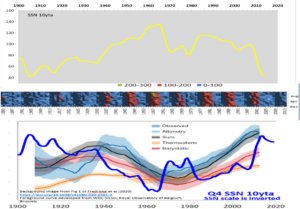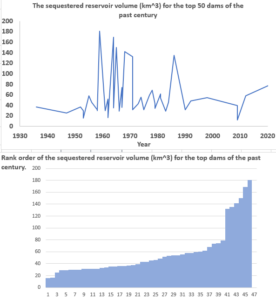Consensus climate change experts have for decades embraced two widely-believed assertions. First, that the sea level has risen about 3mm/year. Second, that all of the sea level rise over the past several generations can be attributed to humans, because of fossil fuel emissions. A new paper [1] now describes that sea level rise over roughly the past century has been about half of that rate. As always there is no regret for the previous decades of alarm. Accompanying the new rate, researchers now disregard solar cycles as a candidate forcing agent, and appear to attribute humans for the increase and the decrease in sea levels simultaneously.
After over a generation of relating selected ice mass changes to sea level changes, apparently always incorrectly, there is a novel explanation for the reduced sea level rise which is finally recognized over the 1970s in particular: the scientists give man-made reservoirs (dams) the greatest credit for slowing that rate down. In other words, they appear to assert that the water budget for such reservoirs is comparable to the immense combined ice fields of Antarctica and Greenland and more.
My preliminary review indicates that surface reservoirs are thousands of times too small in volume to account for any significant fraction of the sea level contribution pie, whether sea levels rise or fall. For example, the draft pie chart above compares an estimate of the relative total human reservoir volume to estimates of the total equivalent volumes of water for Antarctica (blue), Greenland (red), and “mountain glaciers” (green, including the Himalayas, Andes, etc). The thin purple sliver of the pie representing that total human-built reservoir volume, cannot actually be seen, even though it was included in the data for this excel chart. That’s because the volume is simply too low in comparison to each of the others. This virtually invisible sliver of the pie however is attributed by [1] to be the primary receptacle of the missing ocean water that would otherwise be attributed to threaten our coasts around the world.
To reinforce one can consider the pie chart in another way. The ice fields which make up most of the pie chart are the storage of water, attributed by generations of scientists, to naturally regulate the supply of liquid water. I agree as well. The difference is whether one can recognize solar forcing or not. If one cannot, then the surplus and/or deficit of global water has to go somewhere. That seems to be a new purpose assigned to our Earth’s human-built water reservoirs.
And as usual, the researchers have turned a collective blind eye to the Sun. I’m interested myself in the new bends of the researchers’ sea level curve components, so that I can compare to solar “bends”. That’s related to my previous post where I added to the growing body of evidence that a cooling Sun, via the decreasing sunspot number index (SSN), leads to shrinking glaciers and Rising sea levels.
For this post’s featured image, I applied a 10 year trailing average of SSNs to the sea level paper’s figure 1.c. That’s the figure where they outline the general progression of sea level rise and fall over the past century and a decade. I inverted the SSN numbers. In the top graph then, the lowest dips of the blue line signify the highest SSN numbers and the highest peaks signify the lowest SSN numbers. I did this to facilitate the graphic comparison. This is only a blog in any case, and to prove that I’ll simply link to this very speculative and satirical post along with longer term sunspot record coverage.
I’ve included a broad comparison below where the solar values in the uppermost frame are no longer inverted. For the major trends-fluctuations, I think it might be agreed that a long term solar radiation ascent starting in the 1940s was followed by a deep drop in sea level rise rates in the 1970s. And as the solar radiation has diminished since then, the sea levels rose again.
There are many posts at this site along with a paper I authored which explore those topics. Climate change advocates appear to have no comments about this more reproducible solar forcing notion, even as they drift unsteadily in that direction. Maybe they appreciate but are not ready to discuss the value of the new but monumentally obvious perspective that as the radiation our planet receives from the Sun declines, the evaporation from our vast oceans decreases. With less evaporation, the sea levels stay higher, in contrast to the condition if there were more evaporation. Moreover, less moisture is then available in the atmosphere to recharge glaciers and ice fields in high altitude and high latitude catchments. That is expected to cause them to shrink over time.
The sea level paper never mentions any possible connections to Solar Cycles. But at least it doesn’t appear to dwell on fossil fuel emissions as a cause either. That task is typically left to media*. If the new perspective is actually gaining traction, I hope the researchers and their associates in media and politics will consider and attribute the resources and information premiered at this site.
Returning to their attribution of human-built water reservoirs as the primary cause for the slowdown in sea level rise in the 1970’s [1], perhaps some will find their Table 1 amusing, since (as my pie chart above also illustrates) it gives these man-made reservoirs more credit for sea level impact than all of the melted ice from Antarctica, over decades. I took a quick look at data from a common public encyclopedia [2] to plot this curve of greatest new reservoir volumes versus the year going back long before that 70’s minima.
Any can recognize from the top panel that the 1970’s were a time of relatively low reservoir filling. Yet that is the very time that Frederikse et al. indicate that new reservoirs were soaking up the lion’s share of sea level rise. I included the bottom panel as a rank-ordered histogram of the same data. It gives me some added support that I haven’t overlooked important reservoir additions not covered by the top 50 dams listed.
Reservoirs in any case have great value beyond their use as proxies for any alarming climate claims. They are far more dynamic than the authors give them credit for. For example, reservoirs nominally will raise sea level whenever they are releasing water. Any reservoir in fact is all about releasing and collecting water at the best times for the reservoir customers, so both happen routinely. Renewable energy enthusiasts for example may appreciate, that for a dam to generate power, the water in the reservoir must be released.
As a hydrologist, I’m also happy to explore further at this site and even to focus on the critical initial filling period for any reservoir, along with evaporation considerations, groundwater interactions, and the like. This is also only a blog, and accordingly it benefits to express and disclose personal opinions as well as facts and data. It is also informal and none have yet worked to publicly check this post. Readers are encouraged to work out the bean counting of water, reservoirs and sea level rise or fall for themselves. But if any reader is interested, feel free to ask hydrologists to contact me and cc me so that I can address, and learn from some difference of opinion about sea level rise and fall. We can’t all be right.
[1] Frederikse, T., Landerer, F., Caron, L., Adhikari, S., Parkes, D., Humphrey, V.Q., Dangendorf, S., Hogarth, P., Zanna, L., Cheng, L., and Wu, Y.H. 2020 The causes of sea-level rise since 1900. NATURE Vol 584 pp. 383- 399
[2] https://en.wikipedia.org/wiki/List_of_reservoirs_by_volume
*The Ars Technica sea level piece that covers this new paper, authored by a hydrogeologist, leads with an unattributed assertion that “Sea level rise is an unambiguous consequence of climate change”. But I’ve contacted the lead author of [1] and he has not confirmed that he said this to the journalist. Perhaps this is simply the hydro-journalist’s opinion and so I will reach out to Scott Johnson as well.
 18268total visits,7visits today
18268total visits,7visits today



